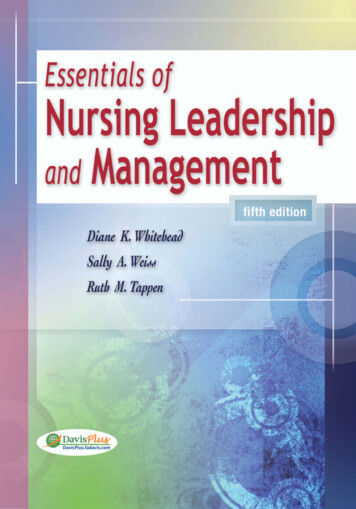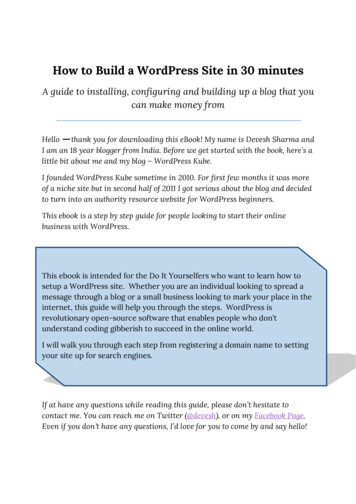
Transcription
A02 KNIG5491 02 FM pp00i-xxvii.qxd8/9/1112:30 PMPage i
A02 KNIG5491 02 FM pp00i-xxvii.qxd8/9/1112:30 PMPage iiBrief ContentsPART IForce and Motion12CHAPTER 3CHAPTER 4CHAPTER 5CHAPTER 6CHAPTER 7CHAPTER 8Representing Motion 2Motion in One Dimension 30Vectors and Motion in Two Dimensions 67Forces and Newton’s Laws of Motion 102Applying Newton’s Laws 131Circular Motion, Orbits, and Gravity 166Rotational Motion 200Equilibrium and Elasticity 232CHAPTERCHAPTERPART IIConservation Laws9 Momentum 26010 Energy and Work 289CHAPTER 11 Using Energy 322CHAPTERCHAPTERPART IIIProperties of Matter12 Thermal Properties of MatterCHAPTER 13 Fluids 405CHAPTERPART IV362Oscillations and Waves14 Oscillations 444CHAPTER 15 Traveling Waves and Sound 477CHAPTER 16 Superposition and Standing WavesCHAPTERPART V507Optics17 Wave Optics 54418 Ray Optics 574CHAPTER 19 Optical InstrumentsCHAPTERCHAPTER609PART VIElectricity and MagnetismCHAPTER20CHAPTER 21CHAPTER 22CHAPTER 23CHAPTER 24CHAPTER 25CHAPTER 26Electric Fields and Forces 642Electric Potential 675Current and Resistance 712Circuits 739Magnetic Fields and Forces 776Electromagnetic Induction and Electromagnetic Waves 816AC Electricity 852PART VIIModern Physics2728CHAPTER 29CHAPTER 30Relativity 886Quantum Physics 922Atoms and Molecules 954Nuclear Physics 991CHAPTERCHAPTER
A02 KNIG5491 02 FM pp00i-xxvii.qxd8/9/1112:30 PMPage iiiAP* EDITIONA S T R AT E G I C A P P R O A C HSECOND EDITIONRANDALL D. KNIGHTCalifornia Polytechnic State University, San Luis ObispoBRIAN JONESColorado State UniversitySTUART FIELDColorado State UniversityBoston Columbus Indianapolis New York San Francisco Upper Saddle RiverAmsterdam Cape Town Dubai London Madrid Milan Munich Paris Montreal TorontoDelhi Mexico City Sao Paulo Sydney Hong Kong Seoul Singapore Taipei Tokyo*Advanced Placement, Advanced Placement Program, AP, and Pre-AP are registered trademarks of the College Board, which was not involved in the production of, and does notendorse, these products.
A02 KNIG5491 02 FM pp00i-xxvii.qxdPublisher:Sr. Development Editor:Editorial Manager:Sr. Project Editor:Editorial Assistant:Media Producer:Director of Marketing:Executive Marketing Manager:Managing Editor:Production Supervisors:Production Management:Compositor and Interior Designer:Cover Designer:Illustrators:Photo Researcher:Manufacturing Buyer:Printer and Binder:Cover Photo Credit:8/9/1112:30 PMPage ivJim SmithAlice Houston, Ph.D.Laura KenneyMartha SteeleDyan MenezesDavid HuthChristy LawrenceKerry ChapmanCorinne BensonBeth Collins, Nancy Tabor, and Camille HerreraRose Kernan of RPK Editorial Services, Inc. andNesbitt Graphics, Inc.Nesbitt Graphics, Inc.Riezebos Holzbaur GroupRolin GraphicsEric SchraderJeffrey SargentCourier KendallvilleStephen Dalton/Minden PicturesCredits and acknowledgments borrowed from other sources and reproduced, with permission, in thistextbook appear on p. C-1Copyright 2012, 2010, 2007, Pearson Education, Inc., publishing as Addison-Wesley. All rightsreserved. Manufactured in the United States of America. This publication is protected by Copyright andpermission should be obtained from the publisher prior to any prohibited reproduction, storage in aretrieval system, or transmission in any form or by any means, electronic, mechanical, photocopying,recording, or likewise. To obtain permission(s) to use material from this work, please submit a writtenrequest to Pearson Education, Inc., Permissions Department, 1900 E. Lake Ave., Glenview, IL 60025.For information regarding permissions, call (847) 486-2635.Many of the designations used by manufacturers and sellers to distinguish their products are claimed astrademarks. Where those designations appear in this book, and the publisher was aware of a trademarkclaim, the designations have been printed in initial caps or all caps.MasteringPhysics and ActivPhysics are trademarks, in the U.S. and/or other countries, of PearsonEducation, Inc. or its affiliates.MCAT is a registered trademark of the Association of American Medical Colleges. MCAT exammaterial included is printed with the permission of the AAMC. The AAMC does not endorse this book.Library of Congress Cataloging-in-Publication DataKnight, Randall Dewey.College physics : a strategic approach / Randall D. Knight, BrianJones,Stuart Field. — 2nd ed.p. cm.Includes bibliographical references and index.ISBN 978-0-321-59549-21. Physics—Textbooks. I. Jones, Brian. II. Field, Stuart. III. Title.QC23.2.K649 2010530—dc221 2 3 4 5 6 7 8 9 10—CRK—13 12 11 10 09www.PearsonSchool.com/AdvancedISBN 10: 0-132-83211-9(High School Binding)ISBN 13: 978-0-13-283211-3 (High School Binding)
A02 KNIG5491 02 FM pp00i-xxvii.qxd8/9/1112:30 PMPage vAbout the AuthorsRandy Knight has taught introductory physics for 28 years at Ohio State Universityand California Polytechnic University, where he is currently Professor of Physicsand Director of the Minor in Environmental Studies. Randy received a Ph.D. inphysics from the University of California, Berkeley and was a post-doctoral fellowat the Harvard-Smithsonian Center for Astrophysics before joining the faculty atOhio State University. It was at Ohio that he began to learn about the research inphysics education that, many years later, led to Five Easy Lessons: Strategies forSuccessful Physics Teaching, Physics for Scientists and Engineers: A StrategicApproach, and now to this book. Randy’s research interests are in the field of lasersand spectroscopy. He also directs the environmental studies program at Cal Poly.When he’s not in the classroom or in front of a computer, you can find Randy hiking,sea kayaking, playing the piano, or spending time with his wife Sally and their sixcats.Brian Jones has won several teaching awards at Colorado State University duringhis 20 years teaching in the Department of Physics. His teaching focus in recentyears has been the College Physics class, including writing problems for the MCATexam and helping students review for this test. Brian is also Director of the LittleShop of Physics, the Department’s engaging and effective hands-on outreach program, which has merited coverage in publications ranging from the APS News toPeople magazine. Brian has been invited to give workshops on techniques of scienceinstruction throughout the United States and internationally, including Belize, Chile,Ethiopia, Azerbaijan, Mexico and Slovenia. Previously, he taught at WaterfordKamhlaba United World College in Mbabane, Swaziland, and Kenyon College inGambier, Ohio. Brian and his wife Carol have dozens of fruit trees and bushes intheir yard, including an apple tree that was propagated from a tree in Isaac Newton’sgarden, and they have traveled and camped in most of the United States.Stuart Field has been interested in science and technology his whole life. While inschool he built telescopes, electronic circuits, and computers. After attending StanfordUniversity, he earned a Ph.D. at the University of Chicago, where he studied theproperties of materials at ultralow temperatures. After completing a postdoctoralposition at the Massachusetts Institute of Technology, he held a faculty position atthe University of Michigan. Currently at Colorado State University, Stuart teaches avariety of physics courses, including algebra-based introductory physics, and was anearly and enthusiastic adopter of Knight’s Physics for Scientists and Engineers.Stuart maintains an active research program in the area of superconductivity. Hishobbies include woodworking; enjoying Colorado’s great outdoors; and ice hockey,where he plays goalie for a local team.
A02 KNIG5491 02 FM pp00i-xxvii.qxd8/9/1112:30 PMPage viBuilds problem-solving skills and confidenceClear, consistent instructionBuild confidence and success through a consistentthree-step approach: Prepare the problem, try toSolve it, and Assess the answer.Topic-specific Problem-Solving Strategies follow the samethree-step framework and provide more detailed guidance.1 PREPARE reinforces the value of gathering information,drawing figures, making assumptions, and planning—keysteps that research shows are often skipped.12 SOLVE carefully works through the mathematical steps ofthe solution, explaining algebraic manipulations and useof key information.3 ASSESS verifies whether the answer makes sense—numerically and in context.23Tactics Boxes provide step-by-step proceduresthat build key skills that will be used over andover—such as drawing free-body diagrams andusing ray tracing.Math Relationship Boxes ensure confidencewith the key mathematical relationships mostcommon in this course. Each relationship isconsolidated in words, math, and graphics, alongwith tips on reasoning with limiting cases andscaling. Icons in the text refer back to these boxesto reinforce connections.
A02 KNIG5491 02 FM pp00i-xxvii.qxd8/9/1112:30 PMPage viiExplicit, guided practiceWorked Examples implement theStrategies and follow the samePREPARE/SOLVE/ASSESS framework as partof developing good problem-solvinghabits. They carefully walk throughthe underlying reasoning and pitfalls toavoid.Integrated Examples at the end of eachchapter demonstrate problem-solving inthe context of a capstone, multi-conceptreal-world scenario.123Conceptual Examples target qualitative reasoning skills. Since nomath is involved, they follow a REASON and ASSESS approach.Pencil Sketches provide an explicitand accessible example of what to drawin solving a problem—steps oftenoutlined in the Tactic Boxes.13Conceptual QuestionsConceptual Questions require thoughtfulMultiple-Choice QuestionsProblemsGeneral ProblemsPart Summary Problemsreasoning and can be used for group discussions orindividual work. Multiple-Choice Questions usecarefully chosen distractors to elicit common misconceptions. Problems, are keyed to sections and drawon real-world applications to provide motivationalexamples. More advanced General Problemsrequire the simplification and modeling of morecomplex real-world situations. Part SummaryProblems close each of the book’s seven parts andtake problem-solving one step further by coveringtopics that span several chapters.
A02 KNIG5491 02 FM pp00i-xxvii.qxd8/9/1112:31 PMPage viiiINTEGRATES INTERESTING And RELEVANT TOPICSAn active, inductive approachDrawn from various fields of study and the world around us, relevantexamples and interesting topics are carefully woven into the text. Theseprovide motivation, a means to consolidate understanding, and a clearcontext for understanding physics.New concepts are introduced through observations about the realworld, an inductive approach shown to improve learning (see themagnetism introduction in the sample chapter that follows).Worked Examples incorporatescenarios from everyday life and theworld around us.Free-standingApplications, foundin the margin withphotographs and aself-contained caption,connect the physicalprinciples with thereal world.Try It Yourself Activitiesthroughout the text providesimple real-world experimentsdesigned to quickly reinforcea key idea through directexperience.
A02 KNIG5491 02 FM pp00i-xxvii.qxd8/9/1112:31 PMPage ixEngaging treatmentOptional sections provide in-depthcoverage of key topics—such aselectrical conduction in the nervous system,the workings of an EKG, and how to correctlymeasure blood licationsthroughout the textillustrate how physicsrelates to the realworld.Multiple-choice and Passage Problemscarefully test understanding by targetingcommon misconceptions and providingcontext-rich situations.
A02 KNIG5491 02 FM pp00i-xxvii.qxd8/9/1112:31 PMPage xPROMOTES DEEPER UNDERSTANDINGStructured learning pathThis text incorporates many subtle but powerful techniquesthat improve learning and retention, including a self-evidentand structured learning path anda unique visual pedagogy.Chapter Previews are based on the educational psychology concept of an“advance organizer.” Each chapter begins with an illustrated preview of theupcoming ideas, setting them in context, explaining their utility, and tyingthem to existing knowledge (through Looking Back references).Stop to Think Questions at the end of a section allowfor a quick comprehension check before moving on.Using powerful ranking-task and graphical techniques,they efficiently probe key misconceptions and encourageactive reading. (Answers are provided at the end of thechapter.)NOTE Paragraphs point out commonmisconception, common sticking points,and highlight math-related issues thatmay cause difficulties.
A02 KNIG5491 02 FM pp00i-xxvii.qxd8/9/1112:31 PMPage xiProven visual pedagogyFigures are carefully streamlined in detail and color. In addition,chalkboard-like dialogue boxes (versus lengthy captions in othertextbooks) are effectively used in: interpreting a graph, equation,or figure understanding a process translating between text, math,graphs, and figures grasping a difficult conceptthrough a visual analogyCritically acclaimed Visual Chapter Summaries consolidate understanding by providing each concept in words, math, and figuresand organizing these into a coherent hierarchy—from General Principles to Applications.
A02 KNIG5491 02 FM pp00i-xxvii.qxd8/9/1112:31 PMPage xiiMake a Difference withMasteringPhysics asteringPhysics is the most effective and widelyused online science tutorial, homework, andassessment system available.Mwww.masteringphysics.com Self-Paced, Individualized CoachingFor every chapter of the book, MasteringPhysics provides assignable, in-depth tutorials designed tocoach students with hints and feedback specificto their misconceptions.Get Up to Speed on MathMath remediation found within selected tutorials provide just-in-timemath help, allowing students to brush up on the most importantconcepts—while making connections between math and physics. Access When You Need ItAccess an interactive eText of theStudent Edition 24/7. eText pages lookexactly like the printed text, yet offeradditional functionality.Brin
Randy Knight has taught introductory physics for 28 years at Ohio State University and California Polytechnic University, where he is currently Professor of Physics and Director of the Minor in Environmental Studies. Randy received a Ph.D. in physics from the University of California, Berkeley and was a post-doctoral fellow











